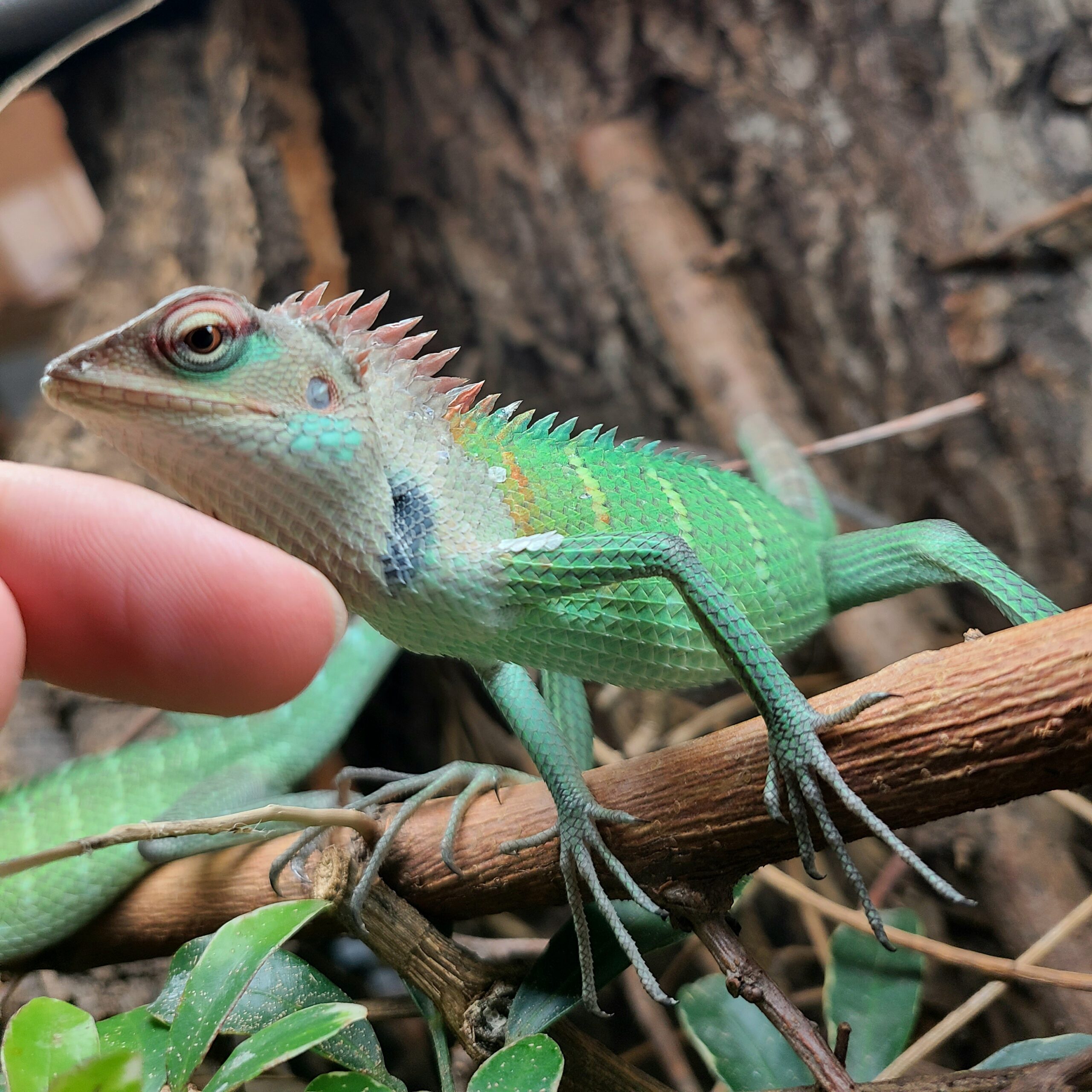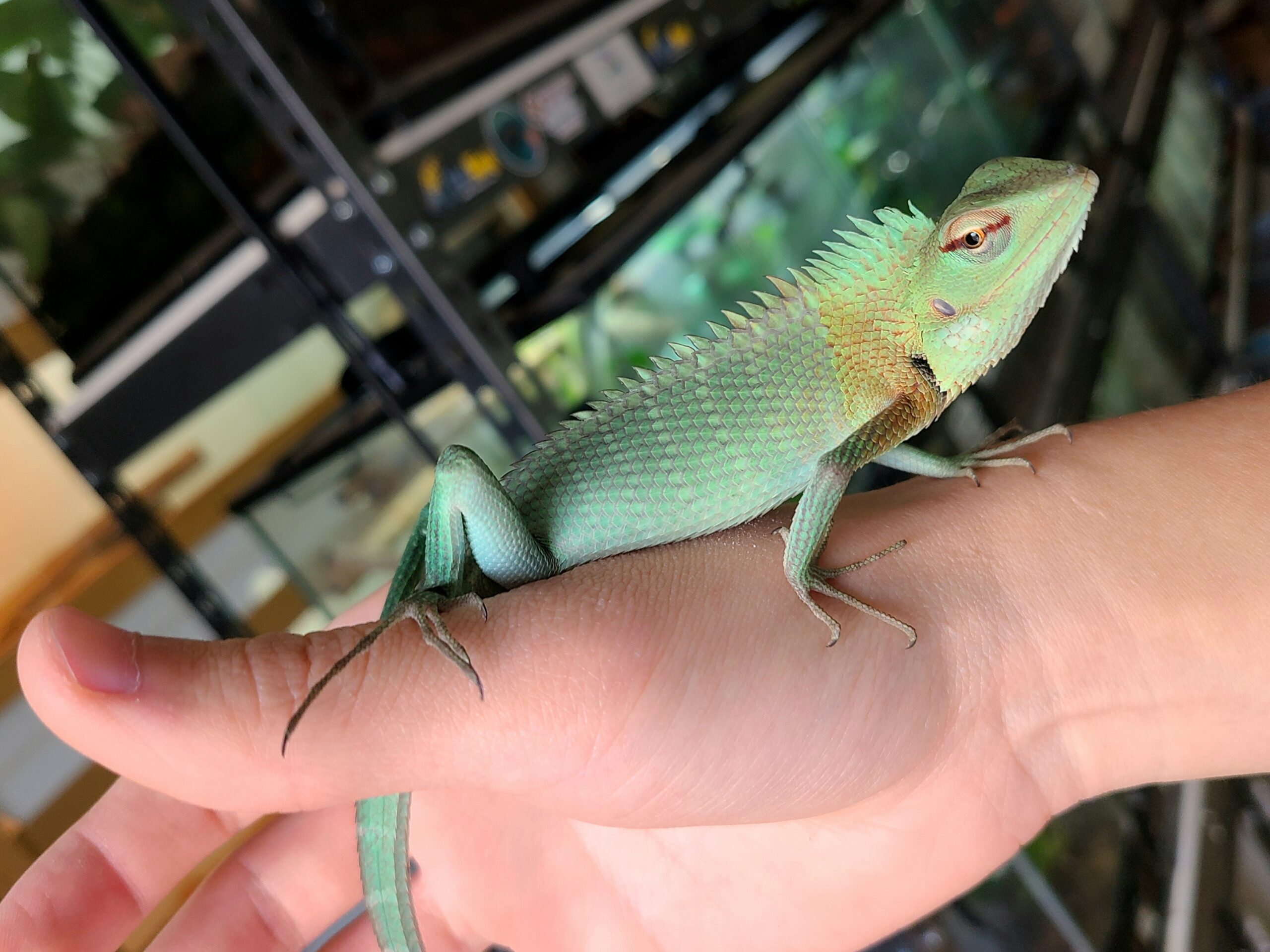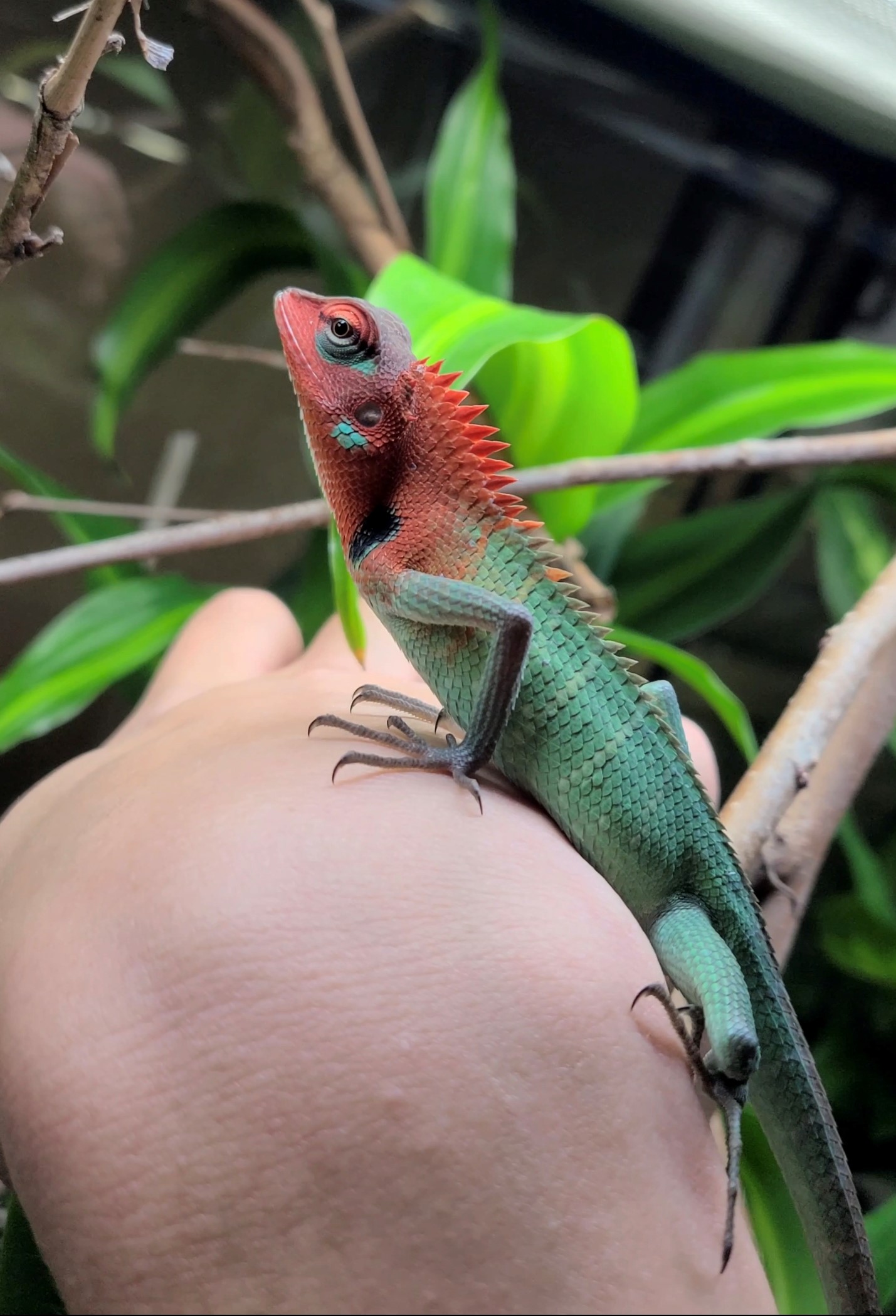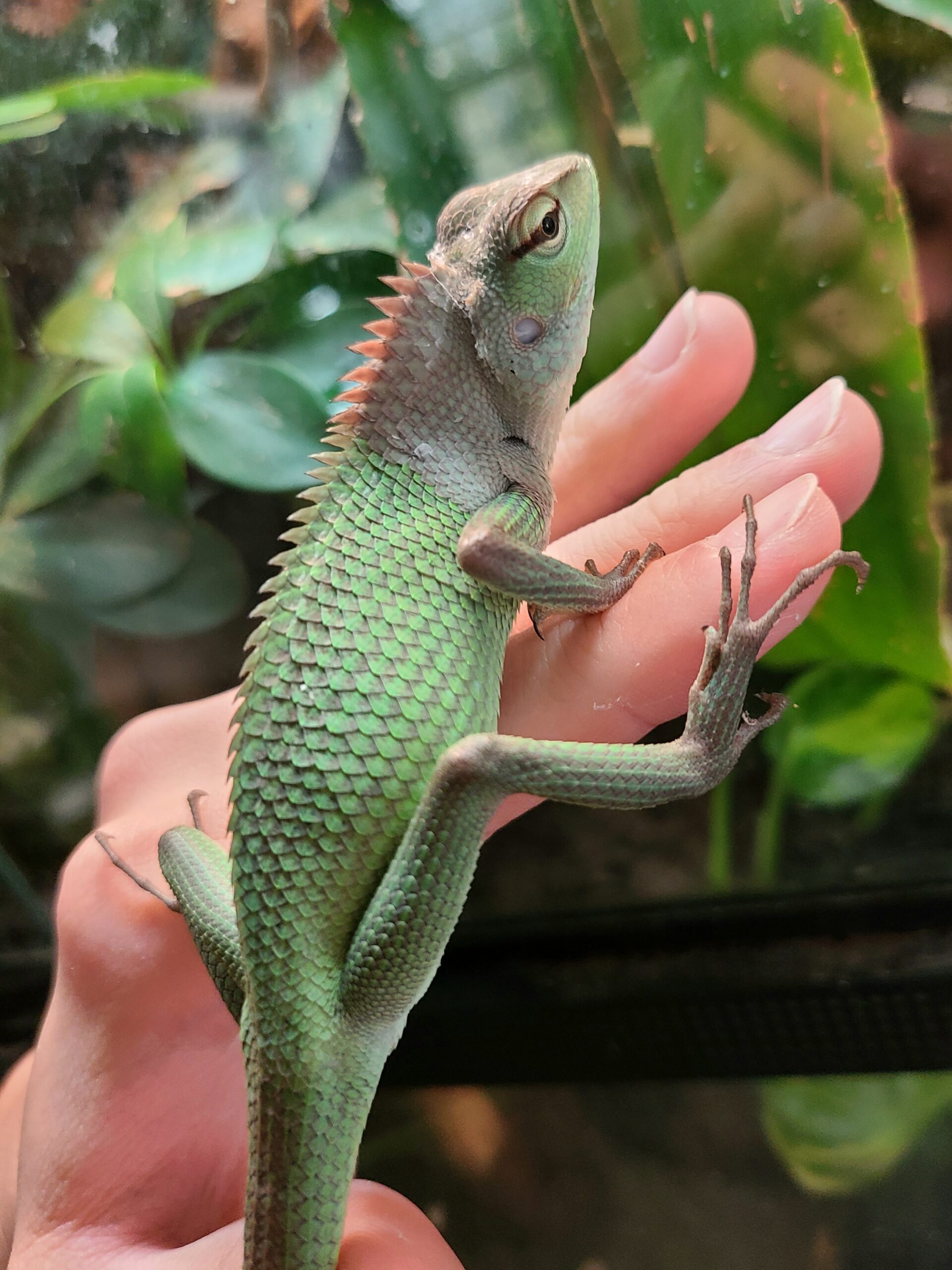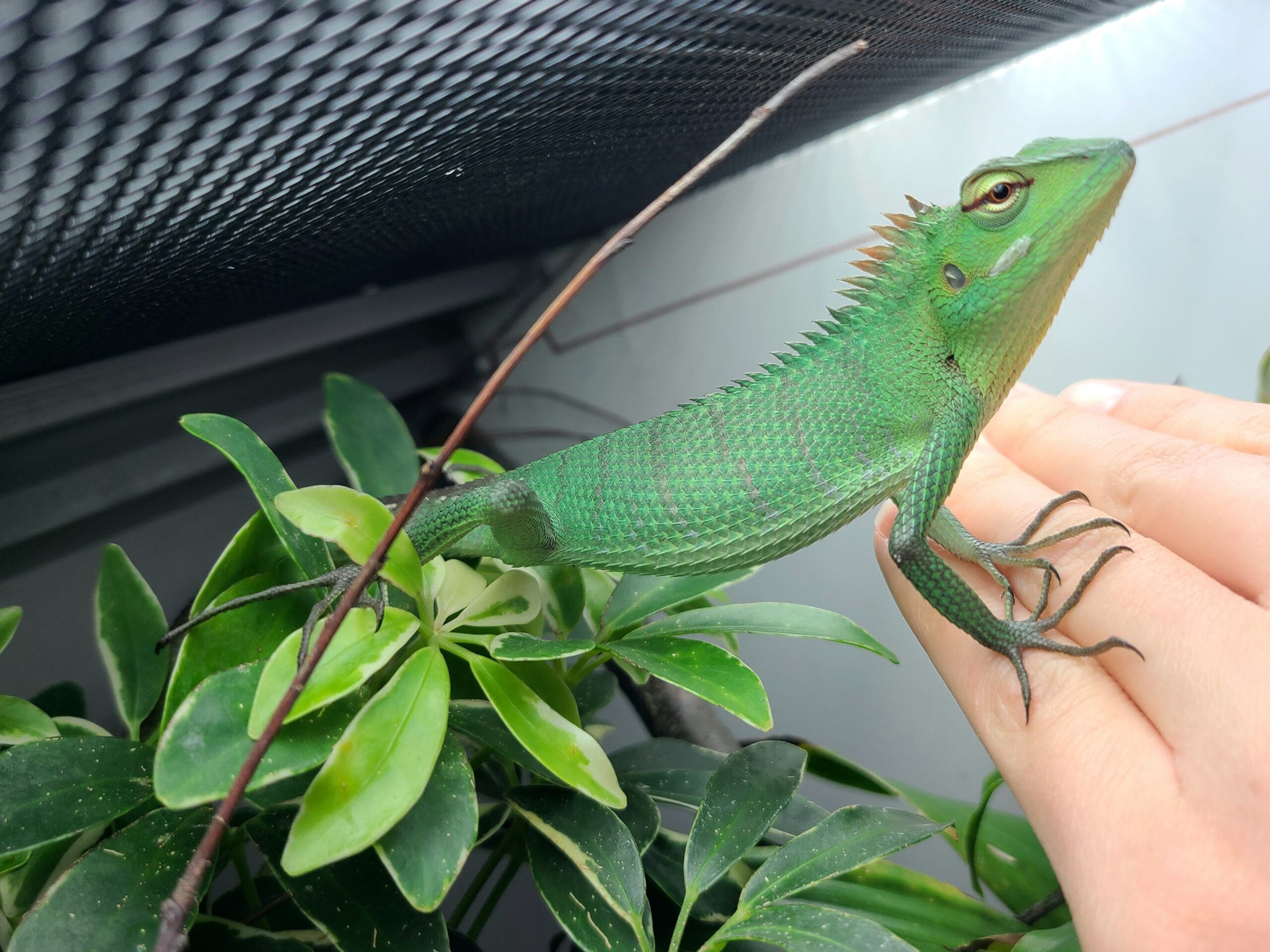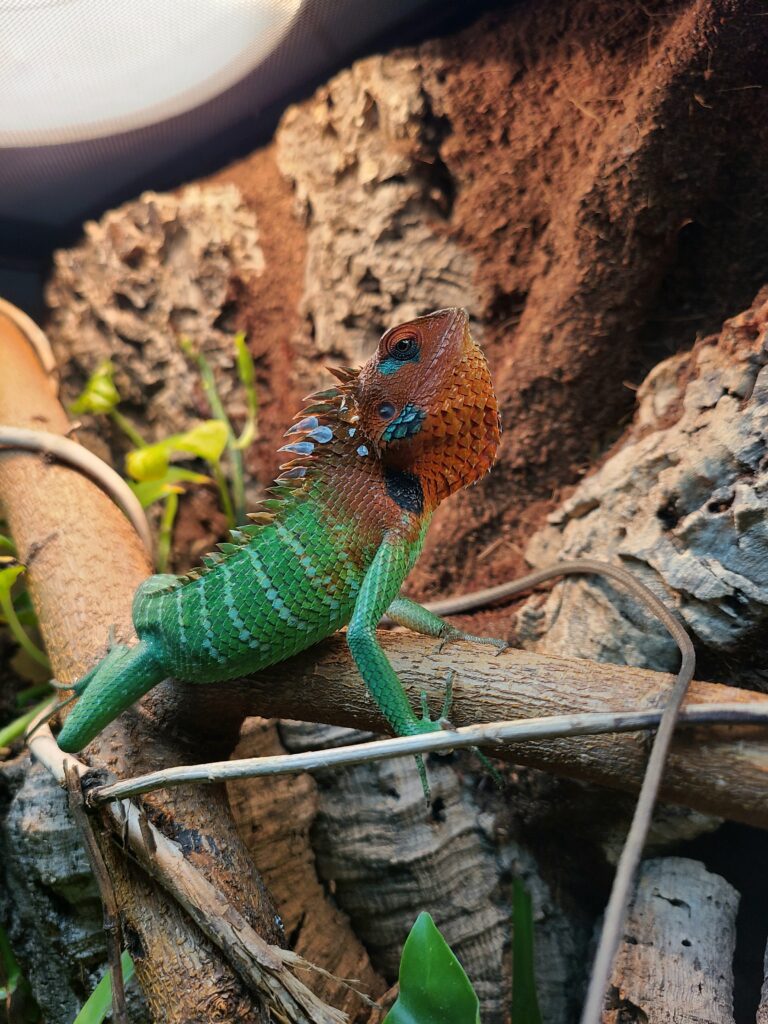
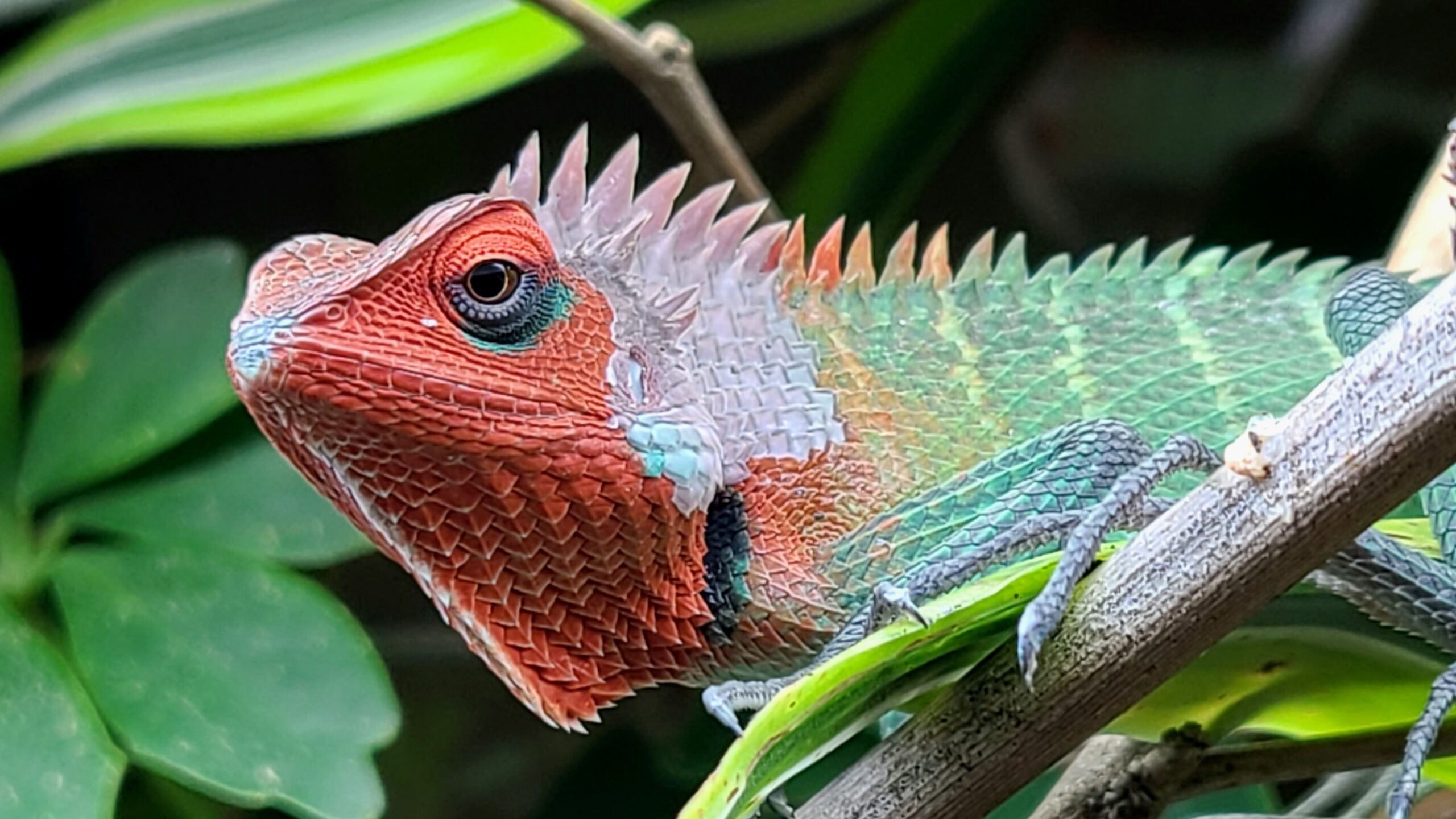
The green forest dragon (Calotes calotes) is an arboreal species of agamid which exhibits vibrant coloration and is capable of acute color change. Few individuals are working with the species as of yet; successful breeding in the terrarium seems to have only been achieved recently, especially within the US. We believe ourselves to have been among the first half a dozen or so breeders within the US to reproduce them in the home terrarium. At the last update to this care article, there is still little to no care information available online for this incredible species. As such, please take our experiences and methods shared here with a grain of salt – we are learning about this species as we go. This article may look quite different several years down the line! We have been keeping and breeding green forest dragons for a little over two years at this point (Last update – September 2024), and are happy to share our methods with you.
Our green forest dragons have proven to be an incredible display species which is remarkably intelligent and full of personality. Green forest dragons, especially males, exhibit a rather unique crest which starts on their head and runs and down their back. They also possess small horns on the back of their head above their ears. Both sexes are capable of rapidly changing coloration of their head and shoulders to a deep scarlet which contrasts well against their deep green base colors. They are incredibly bold in the terrarium, and are almost always out and about. Males frequently put on unique displays where they move their head in circles or semi circles while bobbing and doing push-ups. Females may present smaller displays of their own.
Unlike their more wild parents, our terrarium bred individuals have been warming up to us quickly with a little interaction. They are very intelligent, and have quickly learned to connect us to food. We always know when they are hungry because when we walk by their terraria, they will run up to the glass and check to see if we have insects. Often, when we go into their terraria they will run up and onto our hands looking for food. From there, some overly enthusiastic individuals jump head first into the cup we use to dust our insects in supplement, not willing to wait for us to empty it into their bowls. They tong feed very easily, and many allow petting without much work. We have not spent too much time trying to tame ours, yet most of our now young adults who were raised here are calm enough to allow light handling, which makes us confident they can tame easily.
We have found green forest dragons to be hardy as well as easy to care for and breed. Females are incredibly prolific, and can lay a clutch of 10-15 eggs roughly every 30 days. Our clutches have had a near 100% hatch and survival rate. Green forest dragons are truly an extraordinary species, and we are confident their popularity will rapidly increase in the near future. With not too many breeding these in the US yet, now is a great time to start a breeding project!
If you are considering a green forest dragon for a pet, a lizard housed individually will be happy and healthy; he/she will do just fine with only you for companionship. In this case, we recommend that you give plenty of attention to your lizard on a regular basis through hand feeding, handling, and giving it plenty of time outside of the terrarium. By interacting regularly with your lizard in this way, you provide it with stimulation and an interesting life.
More than one adult male green forest dragon should not be kept in the same terrarium. Adult males are very territorial and aggressive towards each other. They will fight, stress, and potentially kill each other under such conditions. Multiple females may be fine housed together depending on individual personality and age. Most of our females need to be separated at some point, but we do have a few females who get along together even at adult size. Our green forest dragons hatched and raised here cohabitate in pairs well provided sufficient space. Most of our remaining wild caught green forest dragons (wild caught individuals have had a high turnover rate due to health issues they come in with) who originally did not cohabitate very well have warmed up to cohabitation over time.
We currently keep all but one of our breeding green forest dragon pairs together essentially full time, with only one wild caught female who needs some time away from her male occasionally when she is further along in the egg production cycle. In some of our taller terraria, we have a hard time fitting a heated laying site in using overhead heat, so these females are moved out to smaller housing to lay before being placed back in with the male. This has been easier for us than finding a solution for a laying site in the taller terraria, as we already have the other laying terraria set up and ready to go. We will describe laying sites in detail below in the breeding, nesting, & incubation section. We reintroduce females to the main terrarium typically one to two days after they lay.

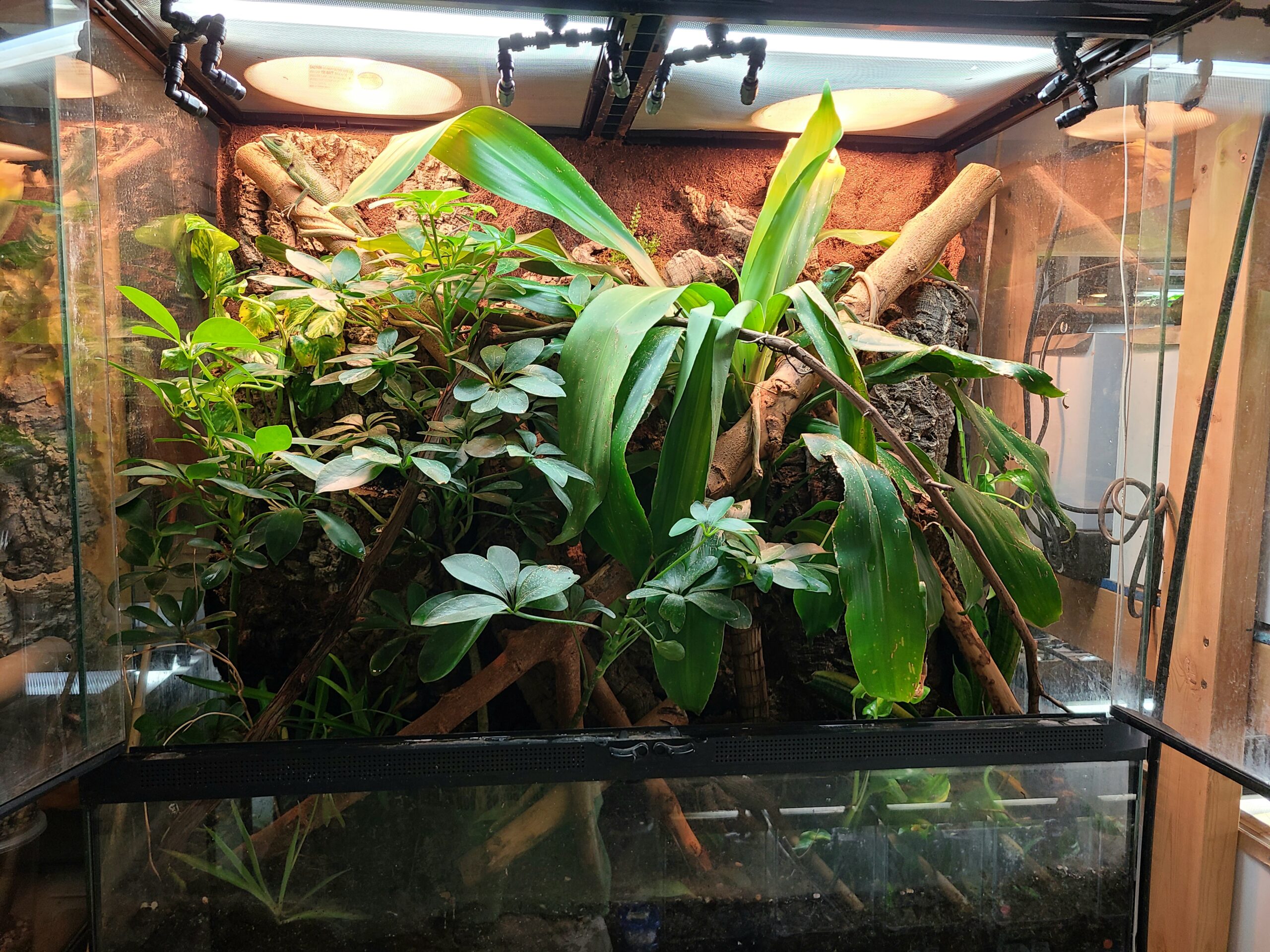
All of our green forest dragons are housed in bioactive terraria. Currently, we use 36” x 18” x 36” glass terraria for our breeding adults. Recently, 4′ x 2′ x 4′ terraria have been releasing through several brands, and this would be a great size for a pair as well. We keep pairs together in these terraria for breeding until the female is separated. In the case seen above, we have a DIY cork bark and spray foam background. Green forest dragons are arboreal, and as such, we use the rough background along with a combination of branches, vines, and live plants as climbing and basking surfaces. The plants also act as cover and can block line of sight in the event one lizard feels the need to shy away from another. We place a thick branch directly under where we plan to place our heat lamps, leading up to each corner of the terrarium.
A water bowl is placed on the floor of the terrarium. A food bowl should be placed in an area of the terrarium that will not get wet from mist – this will drown many insects like mealworms which go into the bowl, and ruin the supplement which should stay dry. We place the mist nozzles on one side of the terrarium, with the food bowl on the other side. In our terrarium shown here, we use a “shooting gallery” style feeder magnetized to the front glass to avoid the spray from the mist nozzles which line the entire front.
For individual housing of adults, we currently use 22” x 17” x 24” or similarly sized terraria. This size is sufficient, especially for younger adults who have yet to reach full size. We find it suitable as temporary housing for lone females waiting to lay eggs, but do find it a bit small for a fully grown adult. We’ve tried 2′ x 2′ x 2′ Dubia brand enclosures, which we find a suitable size for females, but less so for males. Males seem to have more drive to roam, so they do not work as well. We plan on upgrading to 2’ x 2’ x 3’ or similarly sized terraria soon for individual housing, and recommend this size as a minimum for long term housing of individual adult green forest dragons. Dubia enclosures in particular seem very sturdy and well made. In particular, the screen top is very thick and strong compared to other brands, which normally may be an improvement. However, this sturdy screen is also much more rough than other brands. For certain more skittish individuals, this has led to issues bumping noses on the screen top, so we do not recommend Dubia in particular for this species.
These terraria are set up similarly to the larger breeding terraria. Those set up for breeding females include a nesting site, which we will describe in detail in the breeding, nesting, & incubation section. For now, the important thing to know for terrarium layout in such cases is to leave space for a nesting site which will be heated to roughly 90F surface temperature. We typically leave one corner of the terrarium free of most branches so we can lift the nesting site out of the terrarium without too much trouble in order to collect eggs outside of the terrarium.
We are currently testing 4’ x 2’ x 2’ terraria for pair housing in place of the 36” x 18” x 36” terraria. The tall terrarium size works, but provides less “floor” space for branches for the lizards to climb around in with its smaller footprint. In the tall terrarium, the Calotes largely spend their time in the upper third of the terrarium, while coming to the middle third to cool down if desired for thermoregulation. They almost never use the full height of the terrarium by going into the bottom third of the terrarium. Thus, we feel trading some height for horizontal climbing space would be more ideal. The smaller footprint of the 36” x 18” x 36” terraria also makes it more difficult to fit a nesting location in if so desired, while the height makes it more difficult to heat the nesting location appropriately. 4′ x 2′ x 4′ terraria would also provide this larger footprint along with lots of height for them to move around in. We really would love to see a 3′ x 2′ x 3′ or 4′ x 2′ x 3′ terrarium available on the market, as this would likely be near a “perfect” size in our opinion. You can sometimes find these around at smaller PVC terrarium producers, but currently the price is usually about the same as the larger terraria or higher.

We generally prefer to keep our sources of UV and heat separate. This allows the lizard to regulate body temperature and UV exposure separately. As such, we use a combination of incandescent bulbs and fluorescent tubes to provide heat and UV.
In our experience, green forest dragons tend to prefer a body temperature of roughly 90F. In our facility, we can reach a 90F basking temperature near the top of the terrarium using 2 T5HO bulbs. Originally, we used dual bulb fixtures for this, but due to quality dual bulb fixtures becoming harder to find on the market lately, we have begun using 2 separate single fixtures, which works just as well. We use one UV bulb with strength dependent upon distance to the basking site. For taller terraria, we use a 12% or 10.0 UV bulb, while we use 6% or 5.0 for our shorter terraria. The other T5 fixture houses one 6500k daylight bulb. The 6500k bulb really helps brighten up the terrarium and bring out the colors in the lizards, in addition to being good for live plants.
In addition to these, we do offer a basking spot of roughly 100F in order to allow the lizards to warm up more if they feel the need to. Studies have shown that sick lizards will sometimes give themselves a “fever” by basking at an elevated temperature to help fight the condition. We have noticed that lizards who have eaten a lot recently will often bask at an elevated temperature as well, perhaps to aid in the digestion of their food. As such, we like to provide a basking site that is at least a few degrees warmer than their preferred body temperature.
The heat from these spots also helps raise ambient temperatures in the terrarium, and pulls the 90F basking area further down so that it is not limited to the very top of the terrarium. In breeding terraria, we offer two such spots – one in each back corner of the terrarium. This ensures both lizards may bask in peace if one feels the need to shy away from the other. The T5HO fixtures are placed just in front of these, which puts them more towards the front of the terrarium and at a bit of a distance to climbable basking area in our breeding terraria with our branch layout – we’ve had success with both 6% and 12% UV bulbs in our 36″ high terraria, and believe at this size the full 12% is not necessary.
We have observed that our green forest dragons will use the 100F basking site fairly often, and have noticed that our gravid females seem to use it most often, perhaps to keep the developing eggs inside a bit warmer. We can achieve this temperature in our larger breeding terraria with 100-watt incandescent bulbs, and 40-watt bulbs in our smaller terraria. In terraria with gravid females, we place a ceramic heat emitter of 100 watts above the nesting site to heat the surface temperature of the nesting site to roughly 90F. This stays on 24 hours a day to keep the nesting site warm.
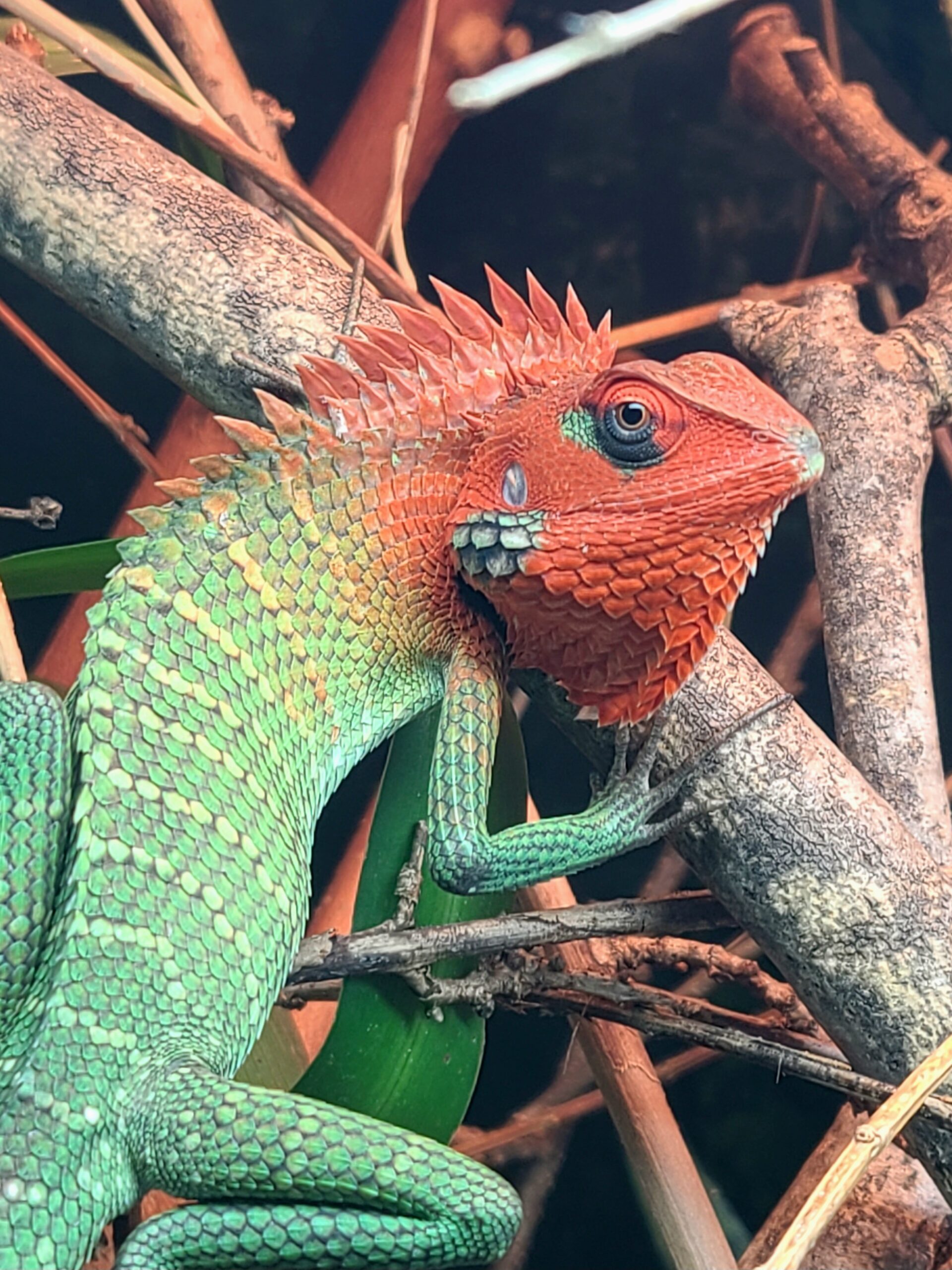
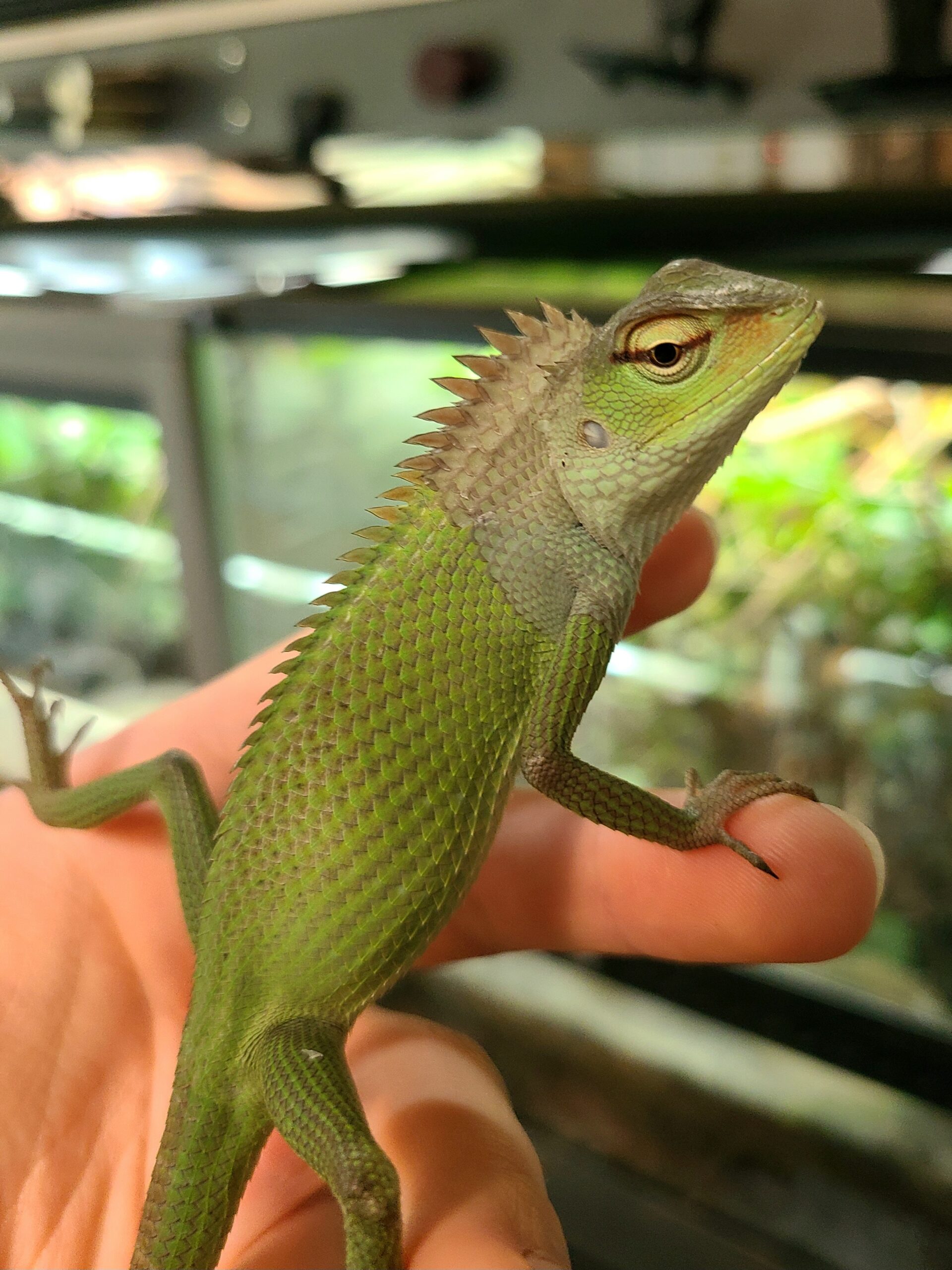
Clean water should always be available. We use an automated misting system on all of our bioactive green forest dragon terraria. When it turns on, the lizards are prompted to drink directly from the mist or from the water which collects on the plants. We run the misting system long enough to allow ample time to drink, but not long enough to overly saturate the terrarium. We try to let things dry out completely between mist cycles with one longer mist cycle in the morning, another in the evening, and a shorter mist mid-day. For us, the longer mists are between one and two minutes depending on the time of year and number of heat lamps active in our facility at the time. The shorter mists are between 30 to 45 seconds. This changes frequently, and we are constantly tweaking timings here and there. We also throw an extra long mist here and there to provide some variety or if we notice things drying out a bit more than expected. We also provide a bowl filled with water in each terrarium as a secondary source. We know they do use these bowls even with misting from observation. We have also done previous testing using only water bowls and no regular misting. The bowls help ensure there is always a water source available at any given moment.
A second bowl is used for food. We usually feed insects every other day, alternating between a staple food item which is almost always available to the lizards, and a more scarce food item which is only available when offered. Staple food items are typically mealworms, super worms, or soldier fly larvae depending on the season, (we grow most of our own insects, and only grow soldier fly larvae during the summer). Scarce food items are usually a variety of tropical roach like lobster or dubia roaches. We may sometimes have other insects like hornworms, waxworms, or butterworms which also fulfill this role well.
When we feed our staple insect (most often mealworms), we offer enough in the bowl to last 3-4 days. We call these our staple insects because we feed an amount to last a while, with most being eaten by the end of day 2 or 3 typically. Our green forest dragons are used to having these available at almost all times. Any staple insects that have lasted until day 4 are few in number and have become lethargic enough that green forest dragons often ignore them. Usually, these can be mixed in with the next group on day 4 and re-dusted in supplement before being put back in the bowl – the new worms wiggling around often stimulate the old ones so they move enough to look tasty again!
When we offer our scarce insect (most often a tropical roach variety), we typically tong feed as many insects as they are willing to take from us at the time of feeding. Because they are not available at all times, they are more novel and are typically eaten straight away when spotted by the lizard. Often, our green forest dragons will get excited when they see us offer a roach to another lizard from a neighboring terrarium and run over to try to reach the insect! This makes our scarce insects a great choice for dusting in supplements only offered periodically because we know the lizard will eat it right away before supplement begins to fall off.
We don’t feed every day for the same reason. It is good for the lizards to feel hungry sometimes. It prevents them from becoming obese and keeps their appetite up when food is available. This encourages them to eat new insects while they are “fresh” and full of the nutritious diet we raise them on and still coated in supplement. Please note that this is different from not having food available – we have food available essentially at all times to our lizards. We know from experience and observation that they will eat the more lethargic worms, but only once they become hungry enough. If they are only a bit hungry, they may ignore the worms but go out of their way to chase down a more scarce roach.
All food items are dusted generously in “Repashy Calcium Plus with D3”. So generously in the case of the staple insects that a little extra supplement covers the bottom of the bowl. The insects soon shed the supplement, but this particular supplement is eaten by the insects in the bowl. Unlike most supplements, it does not kill them when they eat it. So, putting extra supplement in the bottom of the bowl means that although the lizards are no longer getting the full dosage of supplement by day 2, they are eating insects that have been “gut-loading” on the supplement. We also dust roughly one feeding per week to week and a half in either Repcal with D3 or Reptivite with D3, alternating between the two. As described previously, this is almost always a scarce insect feeding.
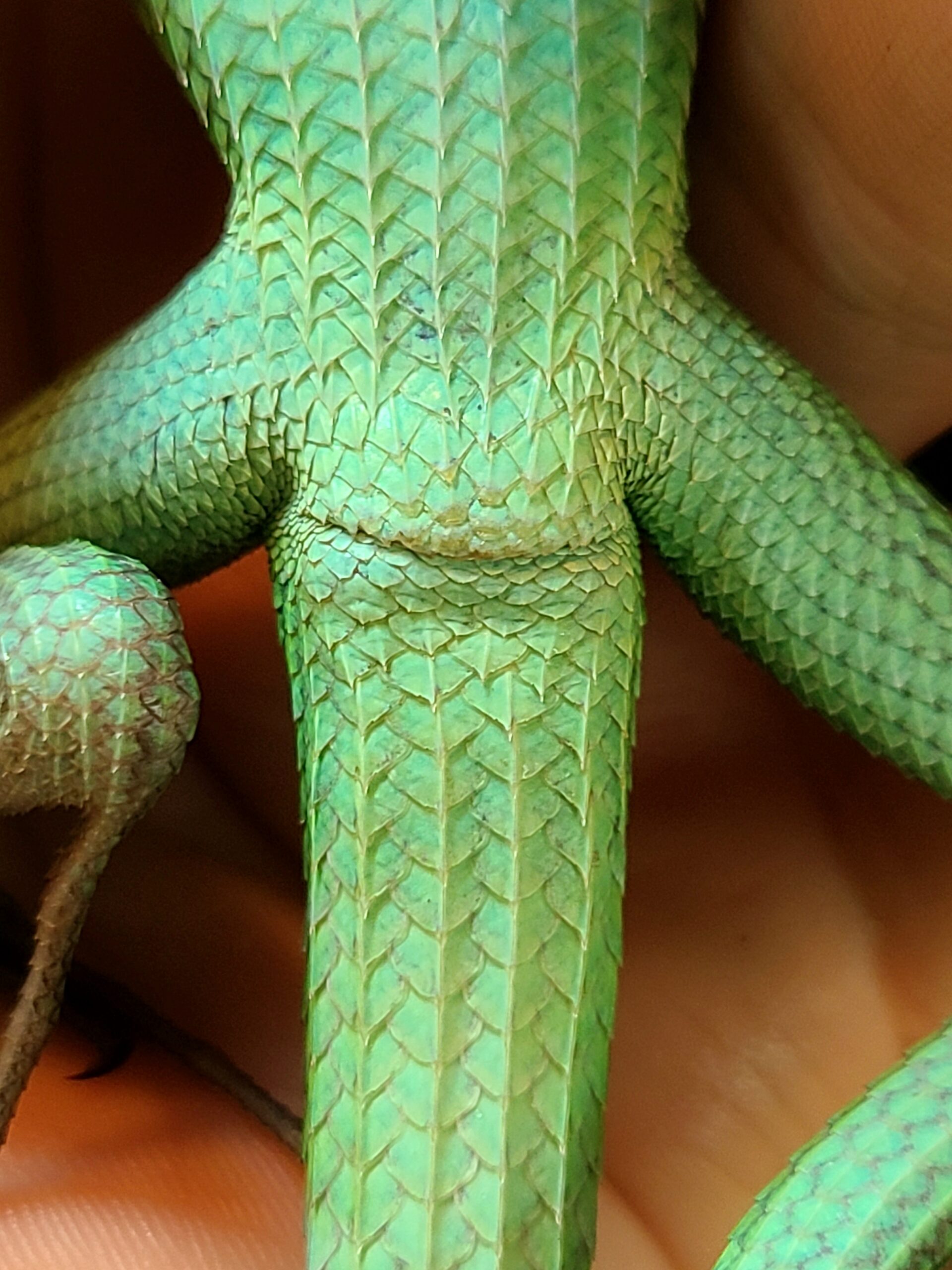
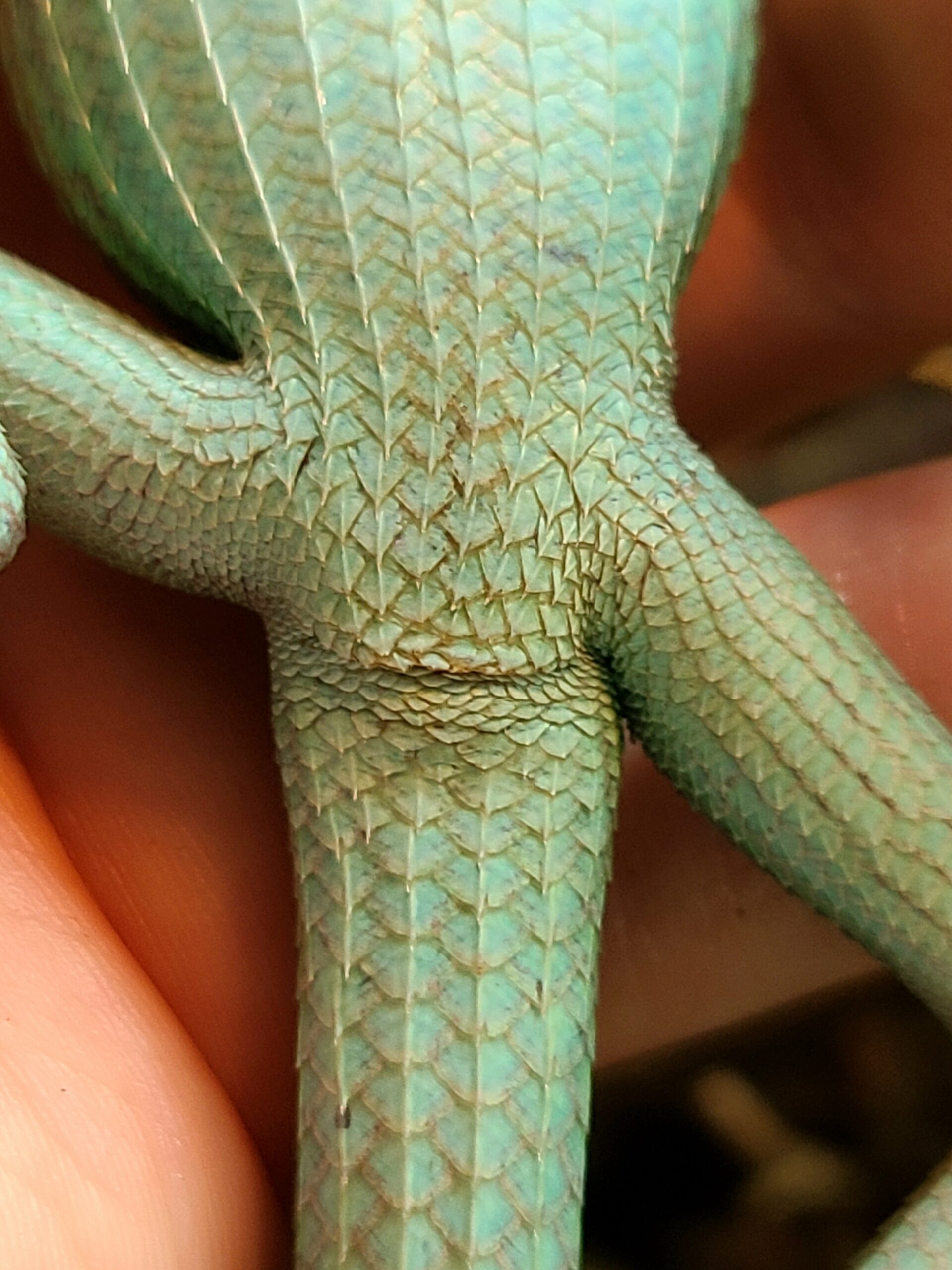
There is little information on sexing green forest dragons online right now, as very few individuals are working with the species, especially in the US! We are learning as we go, so please take our words with a grain of salt.
In our experience, sexing adult green forest dragons is not difficult. Sexing young specimens is more difficult, as the differences are much less easily spotted. In fact, we have heard of many mis-sexings of this species already for those being sold in the US from other breeders. For this reason, we are generally quite conservative on sexing our green forest dragons until we are very confident in the sex of a particular individual.
Males develop a fairly visible hemipenal bulge at the base of the tail as they mature. This broadens the tail base and makes it more flat compared at the base to a female, who has a more rounded tail near the base. A slight concave indent is often visible after the hemipenal bulge on a male. Mature males tend to develop a broader head than females, widening out at the cheeks slightly. At younger ages this is much more subtle. Males also seem to develop crests faster than females, although this does also vary by individual. Although males and females both fire up with the brilliant crimson heads, males tend to do so more frequently, especially in the presence of another male.
Both sexes darken in color when stressed, sometimes almost to black. At the same time, they display lighter colored vertical stripes along the body. Usually, we see this when a juvenile has avoided our hands attempting to transfer him to another tank several times in a row and is not very happy with us. However, males seem to display these vertical stripes under more normal conditions and without the darkening of the base color across the rest of the body. Many of our older males seem to almost always have these lighter colored stripes on their body, while females rarely do.
As with many species difficult to sex early on, quickly maturing males are the easiest to spot and may be identified early, as they tend to develop faster than females. A slow developing male may look identical to a female early on, but begin to develop sexual differences quickly a couple months down the line. For this reason, we are generally quite conservative on when we decide to list a green forest dragon as sexed, and try to wait until we have more definitive evidence for sex rather than list what may be a slow developing male as female because it lacks male traits at the moment.
Good signs to look for as definitive evidence of sex as green forest dragons are beginning to mature are the hemipenal bulge for males, and the more rounded, almost pear-like shape of the belly of a female. The earliest we have spotted these definitively so far is roughly 3.5 – 4.5 months for males and a bit later for females, although we may have strong suspicions for some individuals sooner. The other signs discussed above may help you come to a decision on sex, but are not necessarily definitive on their own. You may have a male whose crest does not develop very quickly, or a female whose crest develops more quickly than usual for example.
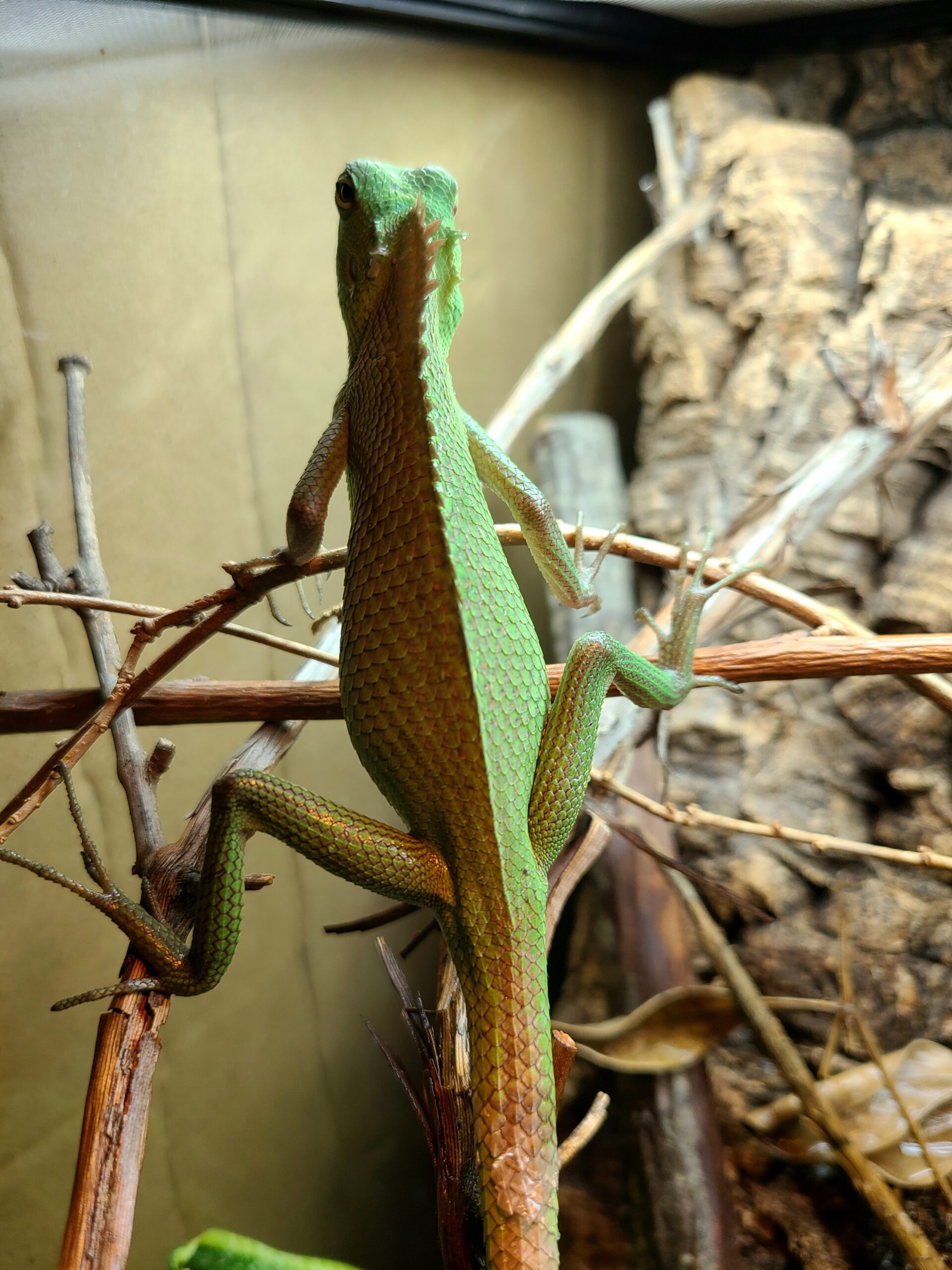
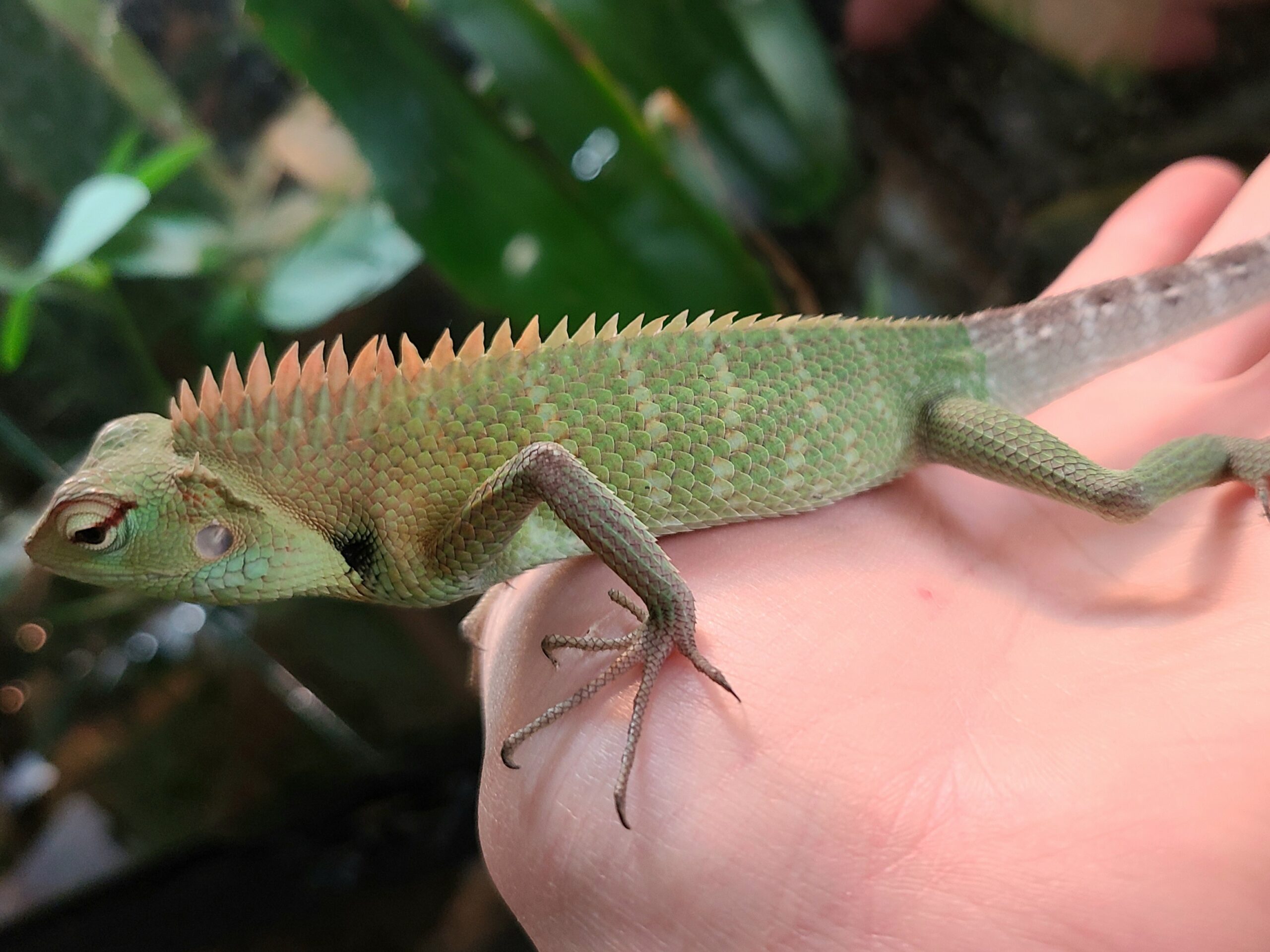
Green forest dragons mature in roughly 7 – 8 months. Once mature, females may begin laying infertile eggs on their own, so make sure to look out for signs of being gravid, and provide a laying site when necessary. The youngest we have observed this is roughly 6 months of age, at which age we have also observed breeding behavior, shortly after which the female successfully produced fertile eggs which went to produce healthy hatchlings. Although 6-8 month olds still have a bit of growing to do before they reach full size, they are most definitely mature young adults ready to breed. Females also will retain sperm. In our experience, a female may produce roughly 3 fully or near fully fertile clutches even after being separated from a male, and after that fertility rate for subsequent clutches begins dropping off quickly.
Green forest dragons are a tropical species and do not seem to need any conditioning or cool down period in order to breed. We are still trying to figure out breeding schedule or seasonality with them which has been slowed down a bit by lack of information and complications with original wild caught adults, so we can’t say with certainty whether they have a slowdown period or not during the year. We should hopefully have more information by the end of next year, as we now have more pairs hatched and raised here who are mature and breeding. In our experience, green forest dragons tend to lay a clutch of eggs roughly every 30 days. Our average clutch size is roughly 12 eggs per clutch, with our largest clutch being 16 fertile eggs and a few infertile eggs.
We originally kept our fully grown wild caught adults together only for about 1-2 weeks to breed depending on the temperament of the female. The female seemed to get irritable as she became further along the egg production cycle. She would not necessarily go out of her way to chase the male, but she sometimes would get nippy with him if he walked too close to her, even if he was not making advances on her. Most often, this started around 1.5 – 2 weeks after introduction, at which point we would separate the female into individual housing with a laying site. She stayed there until she laid, roughly 30-34 days from the laying of the last clutch. After laying, we usually gave her a day to rest, eat, drink, and recover in peace before being reintroduced into the larger breeding terrarium. It is possible this separation and reintroduction may also help induce breeding response on the part of the male.
We now only separate one wild caught female out from the male for any significant amount of time, as they all have warmed up to cohabitation over time. Unlike wild caught individuals, the green forest dragons hatched and raised here have never had any issues cohabitating in breeding pairs when provided with sufficient space, and they continue to produce fertile eggs without separation. In some of our taller terraria, we have a hard time fitting a heated laying site in using overhead heat, so we still separate these females to smaller housing to lay before being placed back in with the male. This has been easier for us than finding a solution for a laying site in the taller terraria, as we already have the other laying terraria set up and ready to go.
After introducing the male and female to the breeding terrarium, we simply wait and keep our lizards well fed and happy! The male may do some rather charming head bobbing and pushups, sometimes drawing small semi circles with his head before chasing down and breeding the female. We have only directly witnessed breeding from our fully grown adults several times, but continue to consistently get fertile eggs from them. Adults who have not been paired before often breed immediately upon introduction to each other.
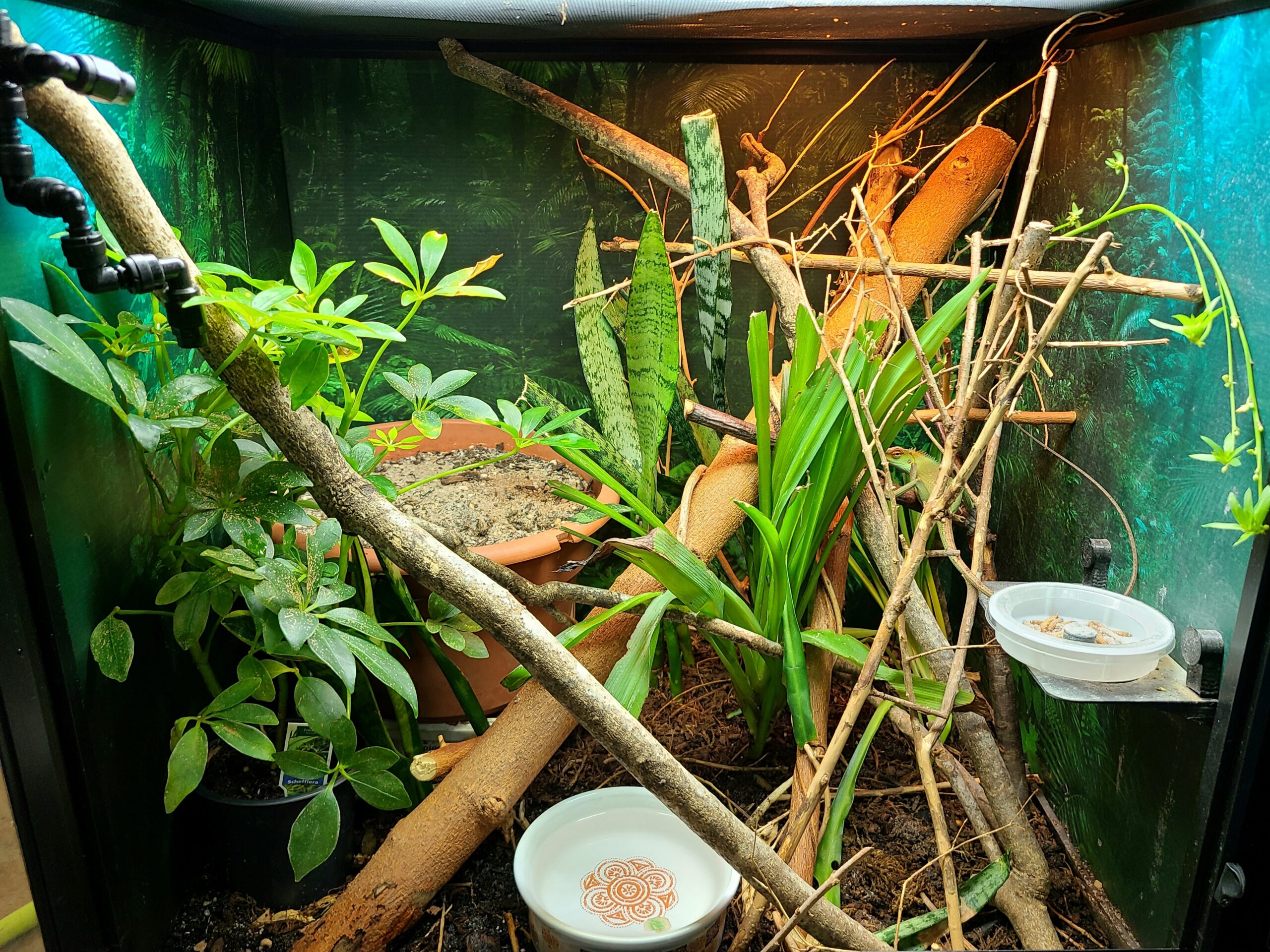
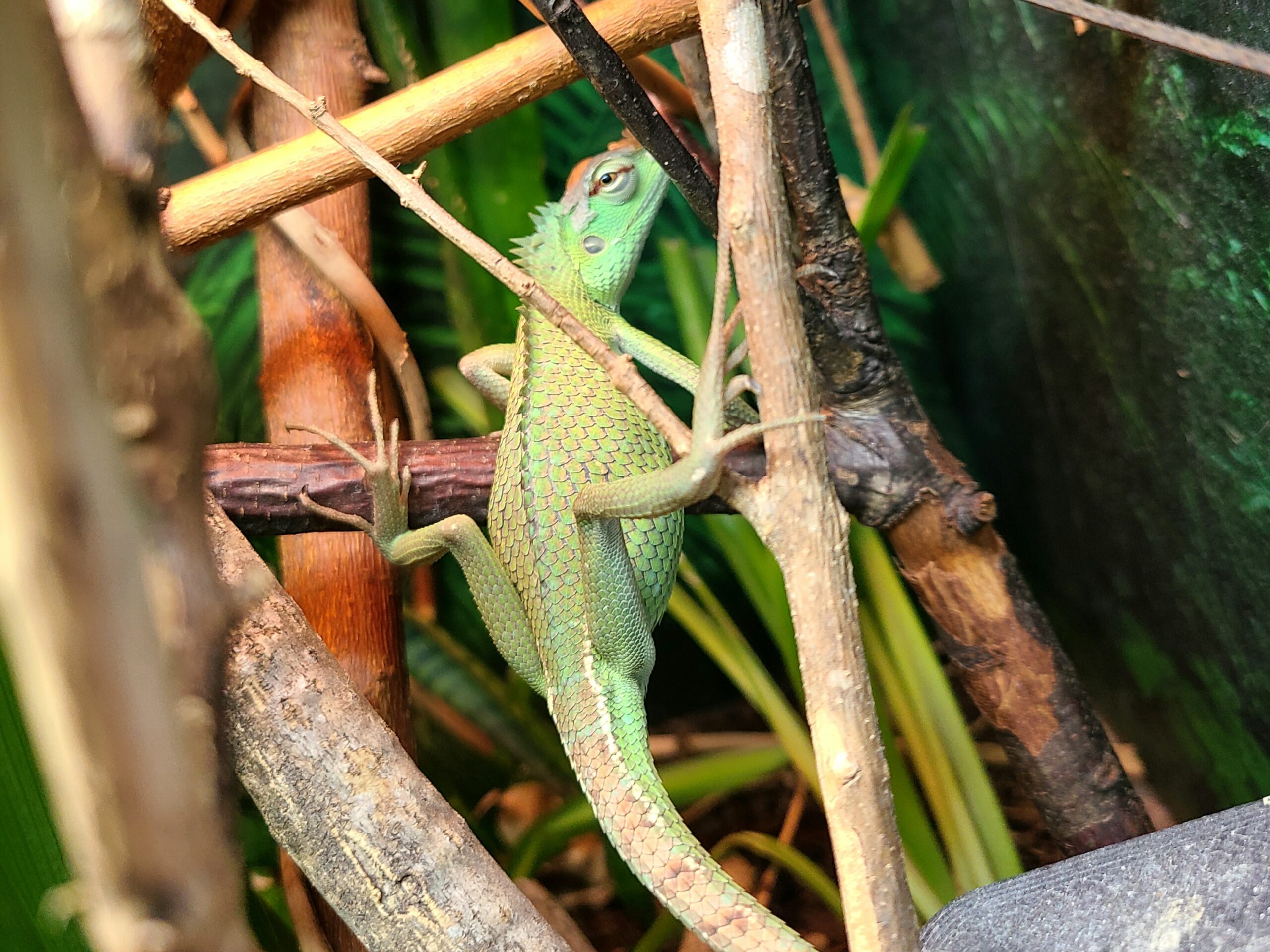
As the female becomes more gravid and is about ready to lay, she will become quite round and her eggs will be visible as small lumps in her sides. We have heard reports from other breeders that females will hold their eggs for long periods if they can not find a desirable nesting site. In our experience, the most important factors for the desirability of the nesting site seem to be temperature and moisture. Green forest dragons seem to prefer a nesting site of 80-84F to lay eggs. We usually aim for a surface temperature of roughly 90F at the hottest point. This creates a gradient of temperature within the pot, with substrate cooling as you go down and outward from the hottest point. This is achieved with a 75W or 100W ceramic heat emitter which stays on 24 hours a day to keep the laying site temperature fairly consistent. You may raise or lower the nesting pot to help reach the desired temperature.
In our case, we use a pot of 10”-12” diameter with a depth of about 6”- 8” as our nesting site. This is likely a larger diameter than necessary, but it is what we had on hand, and the larger size provides a larger gradient of temperatures to choose from. We fill it with a mix of organic potting soil and sand, and leave it open on top without a lid. We usually favor a mix of more sand to soil, but have also successfully used a mixture favoring soil. We have also had females lay in our usual home made bioactive substrate mix in the bottom of the terrarium. We have even missed a clutch of eggs in the bottom of the terrarium once before and had the juveniles hatch out in the terrarium!
We moisten the mix so it is slightly damp but not soggy, and carefully maintain this level of moisture when we know the female is almost ready to lay. After dampening the mix, we pat the soil down and smooth the top layer out, which allows the females to dig burrows without the burrow collapsing and allows us to see when it has been disturbed. The lizards do try to hide their burrow when they rebury the eggs, but can’t match the previous smoothness which makes it easy to identify at a glance.
We then remove the nesting pot from the terrarium and carefully dig up the eggs. Our incubation boxes are Rubbermaid and Ziploc food storage boxes. We have learned the hard way that not all food storage containers are airtight, but those two brands have proven safe thus far. We keep our containers sealed airtight to prevent water loss from evaporation, therefore keeping humidity constant throughout incubation. We prefer containers with clear lids so we can check the condition of eggs without opening the container for the same reason. We only open containers occasionally to check if a dubious looking egg is bad and thus in need of removal. Otherwise, the containers remain sealed until our hatchlings are ready.
The container is half-filled with an incubation medium. Media we have used include vermiculite, perlite, and Hatchrite, which we tend to favor nowadays. We have been using only Hatchrite for several years now because it keeps things easy. Hatchrite is essentially pre-moistened perlite with no preparation necessary. Just be sure to keep it in an airtight container to avoid moisture loss.
The eggs are removed from the nest box and laid on one side in the incubation box, halfway deep in the incubation medium. Eggs should be set at least 1″ apart; further apart is better in the event that a bad egg becomes moldy. We try to set the eggs with the same side up that we found them in the nest, but don’t make too much of a fuss about it. Once all of the eggs have been set in the incubation box, we seal it and record the date and terrarium the eggs are from on the lid. The container is then placed in the incubator.
We incubate our green forest dragon eggs at 84 degrees. We have had a near 100% hatch rate from fertile eggs so far, and a near 100% survival rate from the hatchlings. Our incubation period for green forest dragons at this temperature has been roughly 70 days on average.
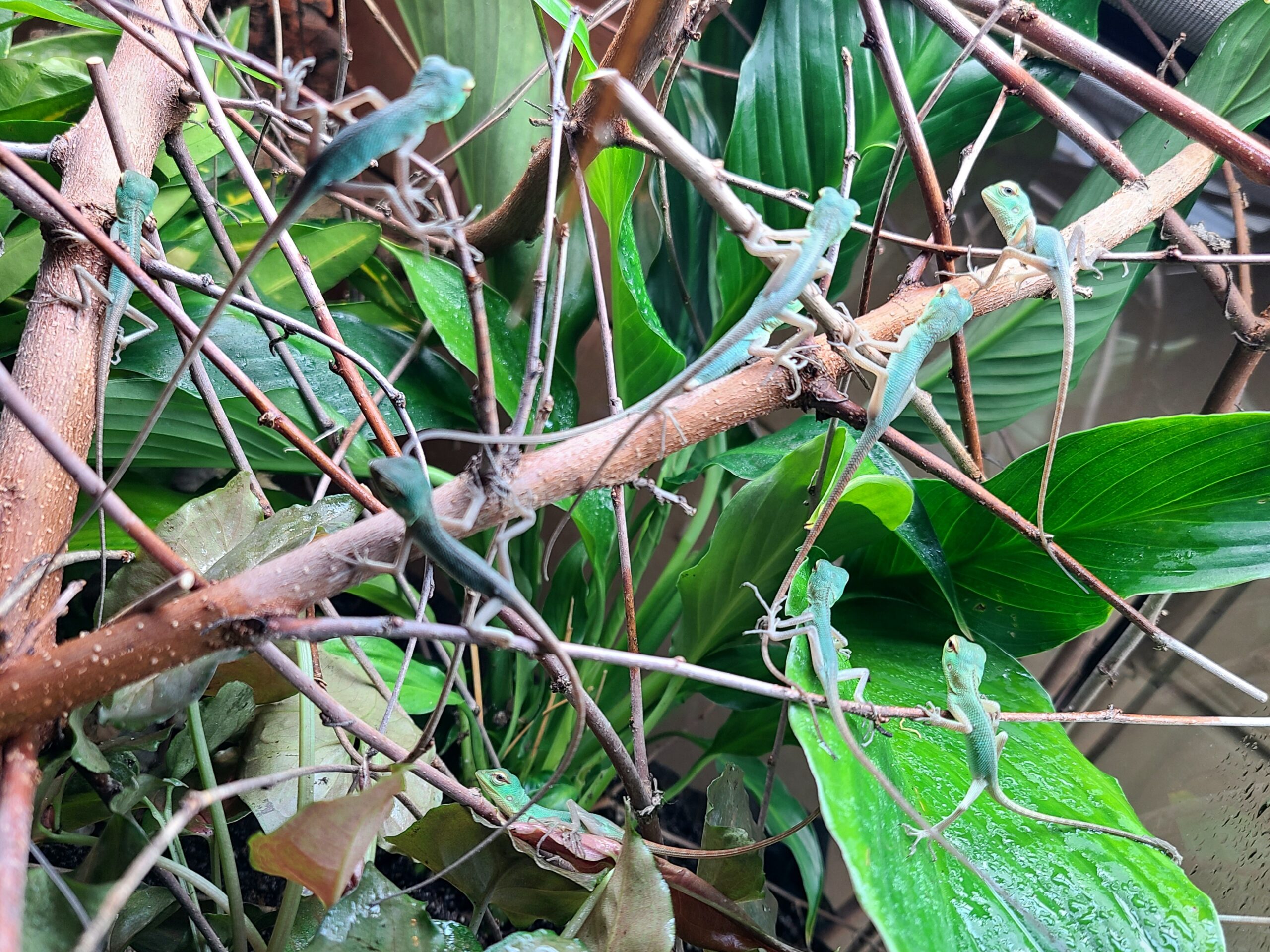
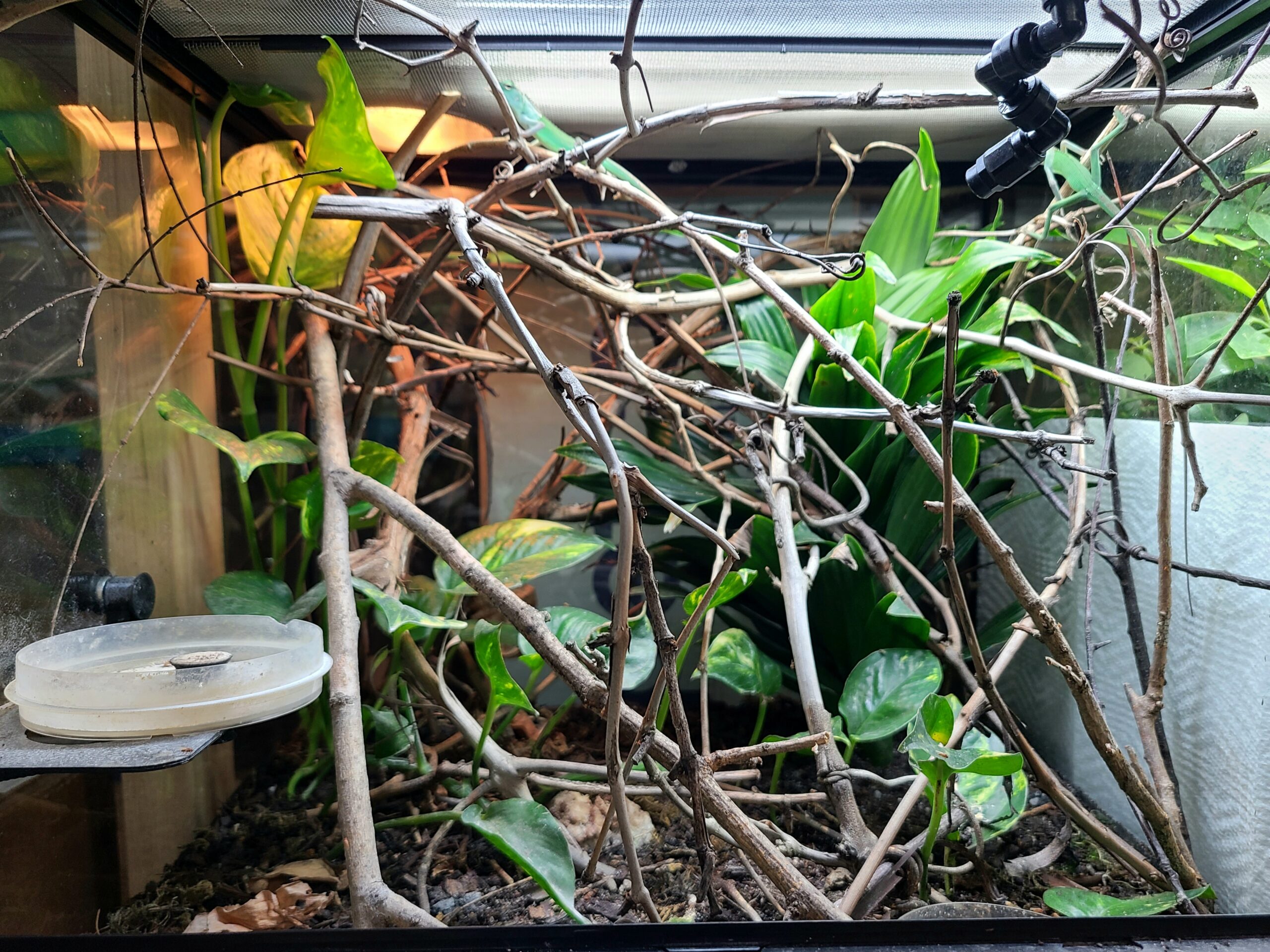
We raise our hatchlings in small 18” x 18” x 18” bioactive terraria. These are set up similarly to the adult terraria but on a smaller scale. Be sure to use a shallow water dish for hatchlings to avoid drowning. The branches are much smaller and twig-like, as young green forest dragons seem to have a strong preference for smaller branches and plants that they can climb on. They are incredibly good climbers even as hatchlings; in fact, they can run straight up your vertical arm with nothing for their toes to grab onto but your bare skin!
The 100F basking site is achieved by a smaller 40W bulb in a Zoo Med Nano dome put on a dimmer switch. This allows us to set the temperature more precisely. We generally don’t take surface temperature readings for these spots due to lack of a large surface to reliably do so. Instead, we observe the lizards in order to decide how much to dim the bulb. Ideally, the lizards should be moving in and out of the basking area as they thermoregulate, spending a fair amount of time both in and out of the basking area, sometimes directly in and sometimes near the edge. If no lizards are sitting under the basking spot ever or only at the edges, it is too hot. If they are sitting very close or tend to not leave the basking area, it is too cool.
Green forest dragons are tiny when they first hatch, being less than one inch snout to vent! This limits food items to very small insects. We do use tiny mealworms and tropical roaches, but one advantage we feel this species has over many other lizards is that hatchlings will readily take fruit flies and bean beetles. Many lizards ignore these smaller insects, but green forest dragons will happily eat a large number of them and grow quickly as a result.
The juveniles are willing to continue eating these small items longer than you may think, but we generally try to get them eating full size mealworms and roaches as soon as possible because once they are capable of eating these larger insects, they do grow more quickly on them – and require much smaller quantities of them too! We feed our hatchlings every day when possible, transitioning to every other day like the rest of our green forest dragons after they transfer mostly on to larger insects like full size mealworms with medium roaches.
We use the same supplementation schedule for our hatchlings as for our adults. We usually use the once a week supplements on bean beetles when possible in this case, as the supplements seem to stick better to them than fruit flies. They are also more novel since we breed fewer of them relative to fruit flies, which helps them be eaten right away while still covered in supplement.
At hatchling size, green forest dragons may be kept in groups. As they mature, they can become territorial, especially males. We generally split groups in half at about 1 – 1.5 months of age, and split in half again at 2 – 2.5 months of age. We try to split out potential troublemakers into different groups. These are juveniles who may chase or posture in an attempt to intimidate other clutchmates – they may do this if they are a male, but also if they are feeling too crowded as they grow.
Eventually, most should be split out individually as they grow. However, we have also discovered recently that individuals who live together in a group, even a smaller group, for a longer period of time tend to have better personalities and are often more bold and significantly more tame without any extra work compared to those housed individually for most of their life. We find this social aspect very interesting, and do try to keep in groups for as long as possible – but we also make sure to keep a close eye on groups for any signs of fighting.
Generally speaking, one male and multiple females can get along fine in a terrarium together, but it is a good idea to split the male out as they near breeding age to prevent unwanted inbreeding. Multiple females seem to be able to get along together without issue in our experience. Our oldest group of females still together is nearly full grown at this point. Males may get along for a while as young juveniles, but at some point will begin to fight with each other due to their territorial nature, so it is a better idea to split anyone displaying aggressive tendencies out early. We house our potential males individually until we are sure of sex. 18” x 18” x 18” terraria still works well for one subadult, but if we have some females still living in groups as they reach subadult size, we usually upgrade the group to a 18” x 18” x 24” or 2′ x 2′ x 2′ terrarium which individuals also go into as they get larger.
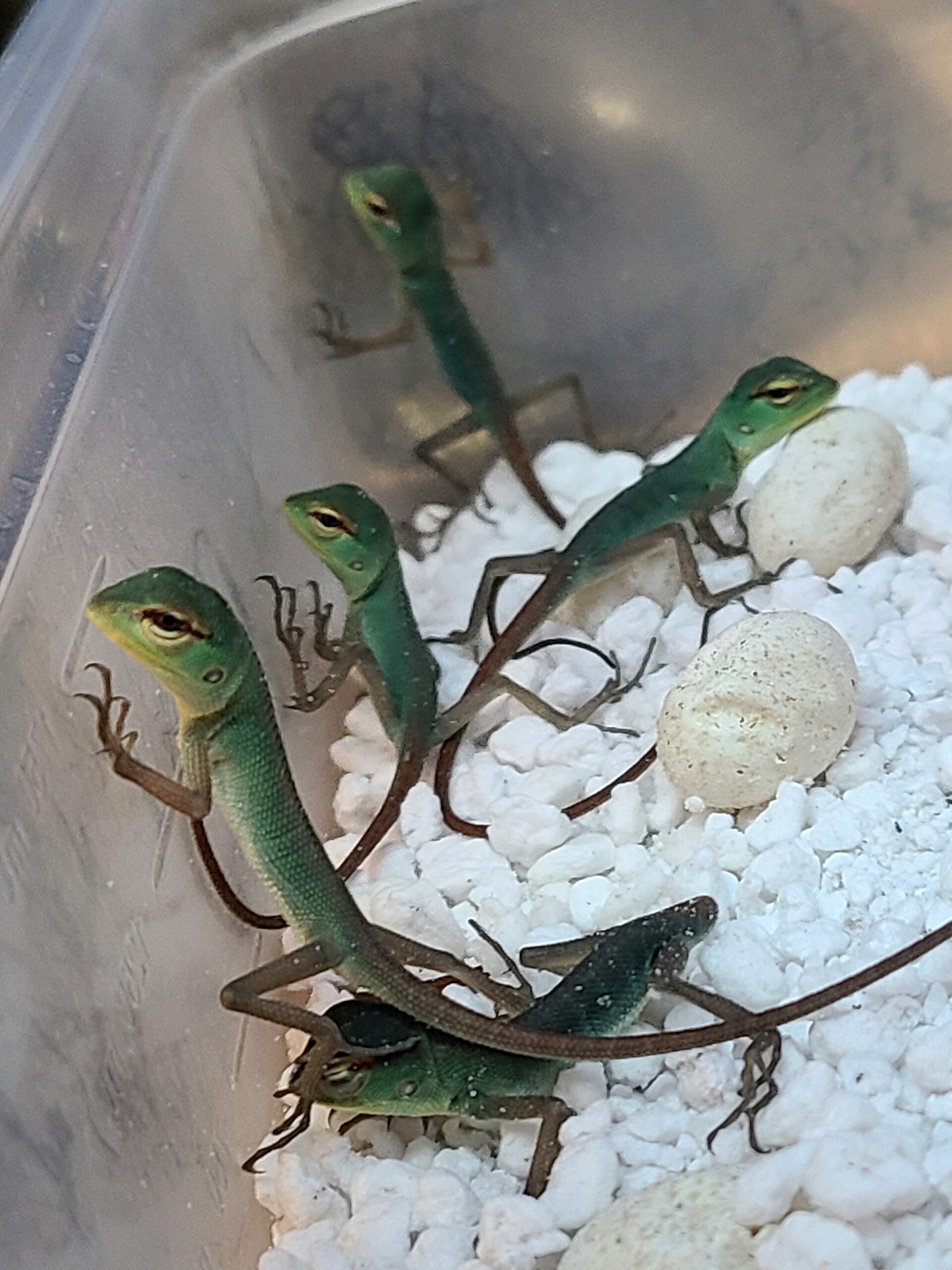
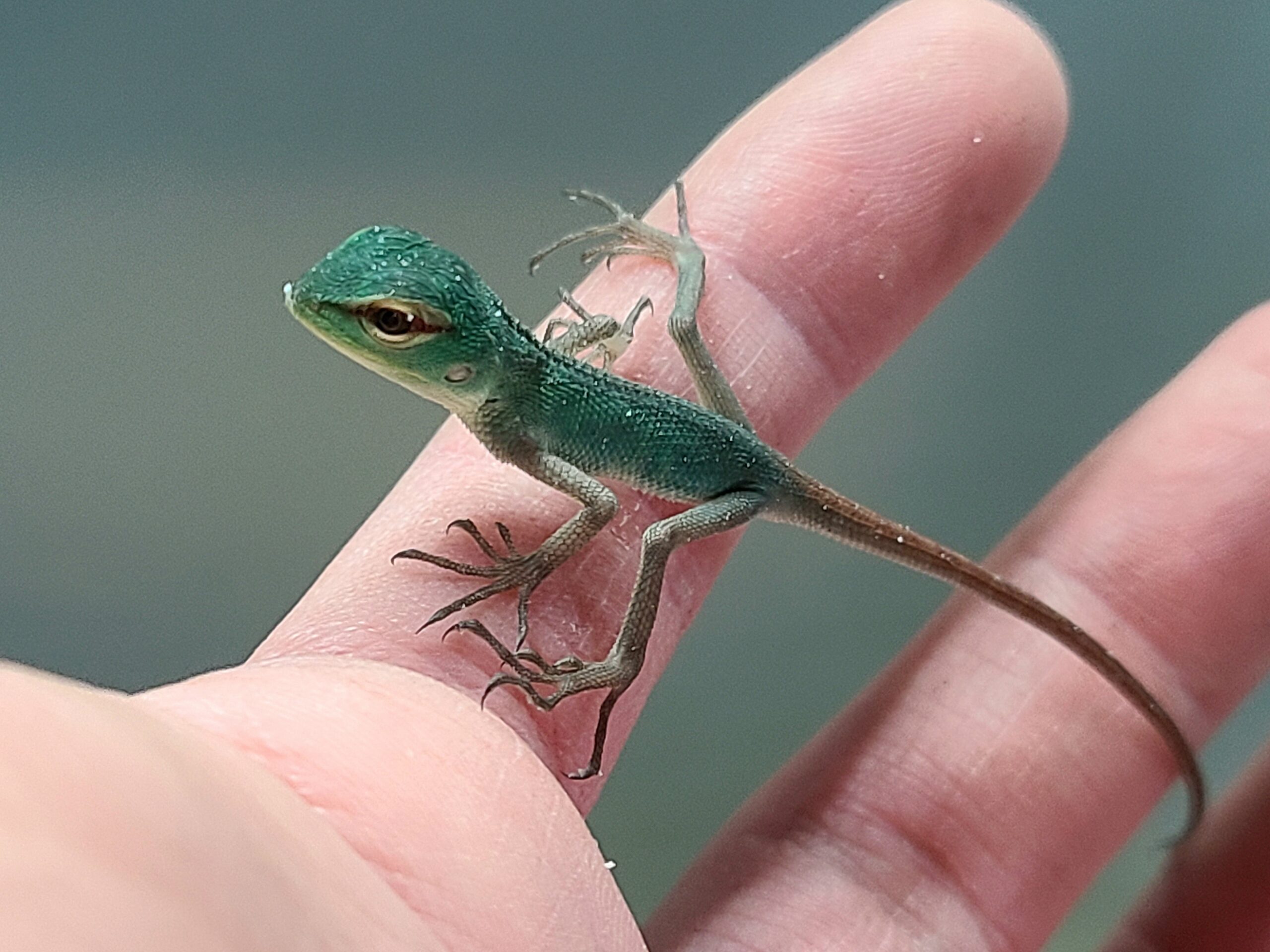
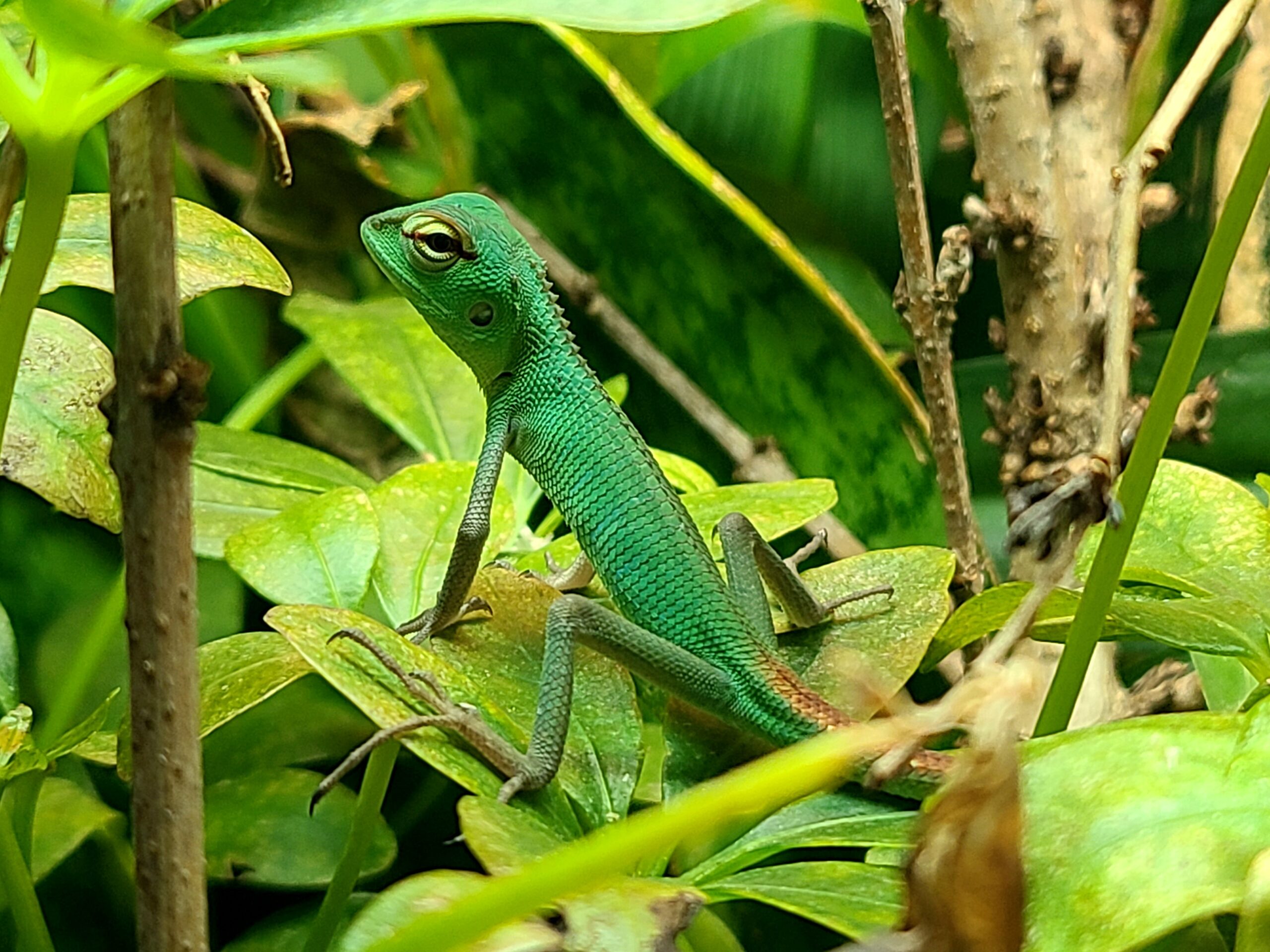
Green forest dragons are truly an extraordinary species which has quickly become one of our absolute favorite lizards we have worked with to date. We strongly believe that they have a bright future in herpetoculture, both as a pet and as an absolutely stunning display species. If you have any questions about the methods described in this article, suggestions, or want to share your experiences with this species with us, please feel free to reach out to us on social media or through email!
